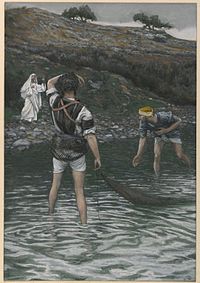Calling of the disciples


The calling of the disciples is a key episode in the life of Jesus in the New Testament.[2][3] It appears in Matthew 4:18–22, Mark 3:16-20 and Luke 5:1–11 on the Sea of Galilee. John 1:35–51 reports the first encounter with two of the disciples a little earlier in the presence of John the Baptist. Particularly in the Gospel of Mark, the beginning of the Ministry of Jesus and the call of the first disciples are inseparable.[4]
Gospel of John[]
In the Gospel of John the first disciples are also disciples of John the Baptist and one of them is identified as Andrew, the brother of Apostle Peter:
The next day John was there again with two of his disciples. When he saw Jesus passing by, he said, "Look, the Lamb of God!" When the two disciples heard him say this, they followed Jesus… Andrew, Simon Peter's brother, was one of the two who heard what John had said and who had followed Jesus. The first thing Andrew did was to find his brother Simon and tell him, "We have found the Messiah".[5]
Andrew is called the Protokletos or "first-called".
Gospel of Matthew[]
The Gospel of Matthew and the Gospel of Mark report the call of the first disciples by the Sea of Galilee:
As Jesus was walking beside the Sea of Galilee, he saw two brothers, called Peter and his brother Andrew. They were casting a net into the lake, for they were fishermen. "Come, follow me," Jesus said, "and I will make you fishers of men." At once they left their nets and followed him.[6]
The Gospel of Luke reports the call by the Sea of Galilee too, but along with the first miraculous draught of fishes. In all Gospel accounts, this episode takes place after the Baptism of Jesus.[7]
The gathering of the disciples in John 1:35–51 follows the many patterns of discipleship that continue in the New Testament, in that those who have received someone else's witness become witnesses to Jesus themselves. Andrew follows Jesus because of the testimony of John the Baptist, Philip brings Nathanael and the pattern continues in John 4:4–41 where the Samaritan woman at the well testifies to the town people about Jesus.[8]
See also[]
- Chronology of Jesus
- Gospel harmony
- Calling of Matthew
- Commissioning the twelve Apostles
- Life of Jesus in the New Testament
References[]
- ^ Bulgakov, Sergei (2008), The Lamb of God, p. 263, ISBN 0-8028-2779-9.
- ^ Morris, Leon (1992), The Gospel according to Matthew, p. 83, ISBN 0-85111-338-9.
- ^ Craddock, Fred B. (1991), Luke, p. 69, ISBN 0-8042-3123-0.
- ^ LaVerdiere, Eugene (1999), The beginning of the Gospel: introducing the Gospel according to Mark, p. 50, ISBN 0-8146-2478-2.
- ^ John, "Gospel", Bible (NIV ed.), Bible gateway, i:35–51
- ^ Matthew, "Gospel", Bible (NIV ed.), Bible gateway, iv:18–22.
- ^ Withrow, William Henry (2009), A Harmony of the Gospels, p. 18, ISBN 1-116-37809-4.
- ^ O'Day, Gail R.; Hylen, Susan (2006), John, p. 31, ISBN 0-664-25260-5.
- Gospel episodes
- Twelve Apostles
- Sea of Galilee